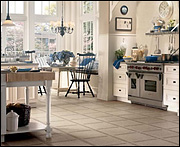Going Green in the Kitchen
 There are many things that go into making a kitchen green, beyond the appliances, countertops, lighting and floors. They are the paints and stains, boxes and drawers and corks and sealants that are used to build your new kitchen.
There are many things that go into making a kitchen green, beyond the appliances, countertops, lighting and floors. They are the paints and stains, boxes and drawers and corks and sealants that are used to build your new kitchen.
Here are some things you might want to think about or at least know about before you start to pick out the products to build your new kitchen.
When it comes to paints, stains and finishes, request that your builder and/or designer uses only water-based products that have no VOCs (Volatile Organic Compounds that contain carbon) or formaldehyde. If you're using wallpapers, look for eco-friendly products that have low or no VOC used in their compositions and glues.
Look beyond your cabinet doors and drawer fronts to the actual box and drawers, because they are generally constructed from particleboard and medium density fiberboard (MDF). These both contain urea formaldehyde glue, which can release toxins into the home. Look for cabinets made from FSC-certified plywood, wheatboard, bamboo or formaldehyde-free MDF.
Your countertops need to be installed on top of a substrate, so make sure that the substrate is made from FSC-certified plywood, wheatboard, or formaldehyde-free MDF rather than particleboard or MDF containing formaldehyde. Other things to look for when choosing your materials for cabinets, counters and flooring:
- Use products that have recycled content, whether post-consumer, post-industrial or agricultural waste.
- Use products that can be recycled, reused or reconditioned when you're through with them.
- Use durable products that have a long lifecycle, so you don't have to replace them as often.
- Use woods that are FSC (Forest Stewardship Council) certified, which means they are harvested from a sustainable, well-managed forest.
- Use products that are rapidly renewable and made from plants that grow to maturity quickly, like cork, bamboo, cotton, etc.
- Use natural products like stone, wood and marble that require little processing, which can create harmful toxins and chemicals.


